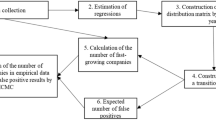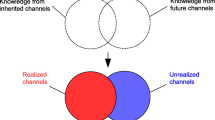Abstract
We investigate company foundations in the German micro technology industry by means of a spatial-temporal micro-geographic analysis. In order to deal with our unusually detailed data, we develop a new distance-based framework for a logistic regression that is able to present results in a continuous space. Locations of company foundations are investigated with respect to their spatial proximity to similar firms, patent owners, related industries and research institutions and are benchmarked with the overall distribution of company foundations in Germany. We demonstrate that spatial proximity has a clear influence on where new companies are founded. Furthermore, the influence of proximity to different agents is not constant over times but evolves with the industry’s life cycle.




Similar content being viewed by others
Notes
Concerning our empirical investigation, we restrict the analysis to 199 research institutions, identified by IVAM-Research as being relevant actors in the German MST industry. For more details, refer to section 4.
For an exhaustive review, see Boschma (2005).
For a detailed analysis of the MAUP, see Openshaw, S. (1984)
By the term “test-statistics” we refer to statistical methods that are in first line index based tests (for instance, Student’s t-test).
Firms founded before 1991
The mentioned industries were selected due to their technology overlap with the MST industry.
We tested a 0 km, 5 km and 10 km threshold
References
Acs ZJ, Anselin L, Varga A (2002) Patents and innovation counts as measures of regional production of new knowledge. Res Policy 31:1069–1085
Andersson M, Hellerstedt K (2009) Location attributes and start-ups in knowledge-intensive business services. Ind Innov 16(1):103–121
Anselin L (2010) Thirty years of spatial econometrics. Pap Reg Sci 89(1):3–25
Armington C, Acs ZJ (2002) The determinants of regional variation in new firm formation. Reg Stud 36(1):33–45
Audretsch DB, Lehmann EE, Warning S (2005) University spillovers and new firm location. Res Policy 34(7):1113–1122
Audretsch DB, Feldman MP (1996) Innovative clusters and the industry life cycle. Rev Ind Organ 11:253–273
Boschma RA, Lambooy JG (1999) Evolutionary economics and economic geography. J Evol Econ 9:411–429
Boschma R (2005) Proximity and innovation: a critical assessment. Reg Stud 39(1):61–74
Brenner T (2004) Local industrial clusters: existence, emergence, and evolution. Routledge, London
Brenner T, Fornahl D (2008) Regional path-dependence in start-up activity. Papers Evol Econ Geograp 8:12
Brenner T, Mühlig A (2012) Factors and mechanisms causing the emergence of local industrial clusters- a meta-study of 159 cases. In: Regional Studies, electronic pre-publication
BMBF (2004) Rahmenprogramm zur Förderung 2004-2009 Mikrosysteme. Bundesministerium für Bildung und Forschung. URL: http://www.bmbf.de/pub/mikrosysteme.pdf
Caniëls MCJ (2000) Knowledge spillovers and economic growth: regional growth differentials across Europe. Northhampton, Cheltenham
Delgado M, Porter ME, Stern S (2010) Clusters and entrepeneurship. J Econ Geogr 10:495–518
Dumais G, Ellison G, Glaeser EL (2002) Geographic concentration as a dynamic process. Rev Econ Stat 84:193–204
Duranton G, Overman HG (2005) Testing for localization using micro-geographic data. Rev Econ Stud 72:1077–1106
Egeln J, Gottschalk S, Rammer C, Spielkamp A (2003) Spinoff-Gründungen aus der öffentlichen Forschung in Deutschland. Nomos-Verlag-Gesellschaft
Fritsch M, Falck O (2007) New business formation by industry over space and time: a multidimensional analysis. Reg Stud 41(2):157–172
Gort M, Klepper S (1982) Time paths in the diffusion of product innovations. Econ J 92(367):630–653
Hotopp U (2002) Teleworking in the UK. In: Labour Market Trends 18 (2002)
IVAM-Research (2005) MST-Atlas Deutschland 2005. Mikrosystemtechnik-Cluster in Deutschland (in German)
IVAM-Research (2006) Gründungsmonitor Mikro-/Nanotechnik 2006. Erfolgsfaktoren für Mikro- und Nanotechnik Start-ups in Deutschland (in German)
Jonas M, Berner M, Bromberg T, Kolassa A, Sözen S (2002) Clusterbildung im Feld der Mikrosystemtechnik-das Beispiel Dortmund. Universität Dortmund, Lehrstuhl Technik und Gesellschaft (in German)
Klepper S (1996) Entry, exit, growth, and innovation over the product life cycle. Am Econ Rev 86(03):562–583
Klepper S (2006) The evolution of geographic structure in new industries. Revue de L’OFCE 97:135–158
Klepper S, Buenstorf G (2009) Heritage and agglomeration: the Akron Tyre cluster revisited. Econ J 119:705–733
Klier T, McMillen DP (2008) Evolving agglomeration in the U.S. auto supplier industry. J Reg Sci 48(1):245–267
Klodt H (2000) Industrial policy and the East German productivity puzzle. Ger Econ Rev 1(3):315–333
Kosfeld R, Eckey H-F, Lauridsen J (2011) Spatial point pattern analysis and industry concentration. Ann Reg Sci 47:311–328
Lasch F, Robert F, Le Roy F (2013) Regional determinants of ICT new firm formation. Small Bus Econ 40:671–686
Lehmann E, Neuberger D, Räthke S (2004) Lending to small and medium-sized firms: is there an East-West gap in Germany? Small Bus Econ 23(1):23–39
Marcon E, Puech F (2010) Measures of the geographic concentration of industries: improving distance-based methods. J Econ Geogr 10(5):745–762
Miller HJ (2010) The data avalanche is here. shouldn’t we be digging? J Region Sci 50(1):181–201
Neffke F, Henning MS, Boschma R, Lundquist K-J, Olander L-O (2008) Who needs agglomeration? varying agglomeration externalities and the industry life cycle. Papers Evol Econ Geograp 08(08):1–34
Openshaw S (1984) The modifiable areal unit problem. Concepts Tech Modern Geography 38
Pérez Pérez M, Martínez Sánchez A, de Luis Carnicer P, José Vela Jiménez M (2004) A technology acceptance model of innovation adoption: the case of teleworking. Eur J Innov Manag 7(4):280–291
Porter M (1998) Clusters and the new economics of competition. Harvard Business Rev: 77–90
Schmude J (2003) Standortwahl und Netzwerke von Unternehmensgründern. Dowling M, Drumm HJ (Hrsg.):Gründungsmanagement: Vom erfolgreichen Unternehmensstart zu dauerhaftem Wachstum: 291–304 (in German)
Scholl T, Brenner T (2014) Detecting spatial clustering using a firm-level cluster index. Reg Stud: 1–15
Sorenson O, Audia PG (2000) The social structure of entrepreneurial activity: geographic concentration of footwear production in the United States, 1940–1989. Am J Sociol 106(2):424–462
Sorenson O (2003) Social networks and industrial geography. J Evol Econ 13(5):513–527
Stam E (2010) Entrepreneurship, evolution and geography. In: Boschma R, Martin RL (eds) The handbook of evolutionary economic geography. Edward Elgar, Cheltenham, pp 307–348
Stuart T, Sorenson O (2003) The geography of opportunity: spatial heterogeneity in founding rates and the performance of biotechnology firms. Res Policy 32:229–253
Varga A (1998) University research and regional innovation: a spatial econometric analysis of academic technology transfers. vol. 13. Springer Science & Business Media
Author information
Authors and Affiliations
Corresponding author
Rights and permissions
About this article
Cite this article
Scholl, T., Brenner, T. & Wendel, M. Evolving localization patterns of company foundationsEvidence from the German MST-industry. J Evol Econ 26, 1067–1087 (2016). https://doi.org/10.1007/s00191-016-0475-3
Published:
Issue Date:
DOI: https://doi.org/10.1007/s00191-016-0475-3




